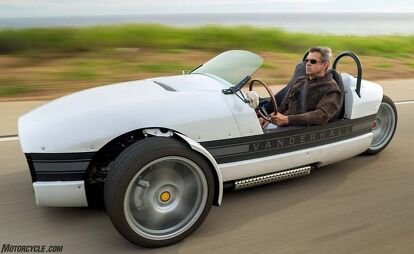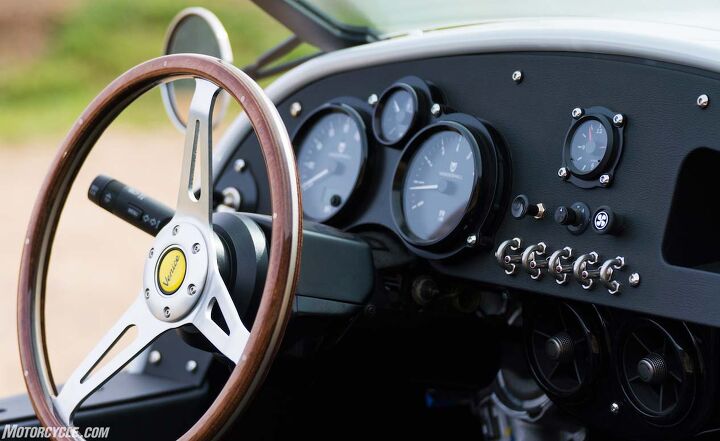2017 Vanderhall Venice Review
Another motorcycle with bucket seats and a steering wheel, but who cares when its this awesome!
If you’re of the opinion the Vanderhall Venice is not a motorcycle and shouldn’t be reviewed by a magazine with the URL Motorcycle.com, don’t read this story and spare us the snide remarks in the comments section. If, on the other hand, you’re open-minded and accepting of the fact the Vanderhall is a reverse trike with bucket seats and a steering wheel, and, by default, a motorcycle as far as the California DMV is concerned, keep reading. Feel free to then leave a comment, snide or otherwise. It’s like voting, if you don’t participate, you have no right to complain.
We spied Vanderhall Motor Works last November at the 2016 International Motorcycle Show in Long Beach, California. Having never heard of the company, our curiosity was piqued, and we were rewarded with the information that Vanderhall was, in fact, a startup roadster company that calls Provo, Utah home. According to the history page of Vanderhall’s website, R&D prototyping dates all the way back to 2010 with a very different chassis configuration and powerplant from the production model tested here. That’s seven years of development time and money invested prior to public consumption. As far as we’re concerned, all that homework resulted in a solid product that performs as good as it looks, which – considering the success of Polaris’ Slingshot – should pay dividends going forward.
We should get one thing understood before progressing any further. It may look expensive, but the base model Venice at $29,950 is relatively affordable considering it’s only $1,451 more than a Polaris Slingshot SLR. Speaking of the Slingshot, we requested the SLR model for what we thought would be a compelling shootout, but Polaris declined to play along. Kind of surprising considering the base model Slingshot won our 2014 Polaris Slingshot vs. Can-Am Spyder F3-S vs. Morgan 3 Wheeler shootout.
From that review we stated, “there was consensus among all editors that when it comes to best bang for the buck, it’s almost impossible to beat the new Slingshot. At only $19,999 for the base model and $23,999 for the upgraded SL version, there’s not much, if anything, that can compete with the Slingshot in terms of fun, performance and wow factor at those prices.”
2015 Polaris Slingshot Review – First Ride/Drive
That was then, but the arrival of the Vanderhall Venice introduces an equally qualified contender frolicking in Polaris’ playground. Hopefully we’ll be able to circle back around to conducting a future shootout because inquiring minds want to know how they match up (Hint: FWD vs. RWD).
The price threshold for Vanderhall’s Laguna, Laguna Sport Premium, and Laguna Bespoke models is in the $50k neighborhood, making those a whole ’nother review. Practical car options in the Venice’s price range include a Chevrolet Camaro ($25,905), Ford Mustang EcoBoost ($26,195), Nissan 370Z ($29,990) – all of which are sporty in their own right but come with doors and roofs and weigh roughly 2,000 pounds extra, and certainly do not have people going out of their way to wave while taking pictures speeding down the freeway. Besides, this car… er, motorcycle, isn’t about practicality. Go visit our sister site Autoguide.com if being practical is what you’re after.
From our perspective, the Venice appeals to the adventurous person who desires something sporty and cool that’s not as common as a Ford Mustang but can’t afford a Porsche. Much in the same way is the appeal of the Slingshot, however, the Venice brings to the table a more elegant, classic style that’s not nearly as Batmobile-ish as the Slingshot.
Viewed from the front, the Vanderhall strikes a more modern, aerodynamic silhouette than a Morgan, which it has to because, while hanging an air-cooled V-Twin out front of a Morgan is sexy, an exposed GM Ecotec four-cylinder is not. The color-matched fenders on our test unit were the only optional items; a stock Venice comes outfitted with unpainted black fenders. Underneath all that white paint resides ABS composite bodywork, whereas the uptown Laguna model is clothed in hand-laid carbon fiber.
Like the Morgan, the cockpit of the Venice is tight to the point of rubbing elbows with your passenger, and there’s a minimal amount of storage room behind the seats. There was enough legroom for my 5-foot-11 height, while there is some fore/aft adjustment in the seat, and the steering wheel tilts up/down as well as adjusts telescopically.
Also similar to the Slingshot and Morgan is the Venice’s proclivity for fair weather. There are no doors and no roof because the windshield is not designed as a support structure (the Laguna model has an available roof and different windshield), no windshield wipers, etc. The heated seats and dual directional heaters do a great job of keeping things pleasant during cool days, but pray it doesn’t rain. At my height, the windshield put windflow right at the top of my noggin, keeping me out of direct air traffic, but it is a motorcycle, so a helmet and moto-gear is always an option for keeping warm, dry and safe(r).
In the canyon twisties the 1,475-pound Vanderhall was a blast to drive aggressively, arcing through corners with precision, and when it’s time to accelerate out of the corner the front-wheel-drive Venice seems to grip and go. The Venice is outfitted with ABS, switchable TC, brake assist, and steering assist, but it doesn’t have the Slingshot’s switchable electronic stability control.
Having said that, I can now see why Polaris and Can-Am outfit their vehicles with these electronic safety nets. For the first time ever aboard a three-wheeler – whether it be a Slingshot, Spyder, MP3, Tilting Motor Works, Tri-Glide or Ural – I rode into a ditch on the opposite side of the road. It was the nth-time through the same corner for a photo op, so maybe I pushed the Venice past its claimed lateral cornering stability rating of 0.95 G because there doesn’t seem to be any other legitimate reason for the mishap, but the incident didn’t slow my pace, and there was no repeat occurrence, so I chalk it up to my own over-aggression.
The irony is, we’ve complained about the electronic grannies on the Spyder, and as soon as we get a trike without those safety nets, I bin it. The aftermath was no damage to the vehicle, largely because there was nothing to smash into, as well as the underside resembling a huge skid plate protecting its delicate parts.
Piloting the Venice is about as visceral experience a you’re going to get outside a bonafide two-wheeler with wind, road and engine noises whirling around with proximate smells, and a 360-degree view. There is no built-in stereo, but the Venice is outfitted with a Bluetooth module and 600-watt door-mounted speakers. Sync your phone via Bluetooth, select your favorite tunes, and you’re rockin’. The exposed speakers are waterproof and are loud enough to be heard at freeway speeds, but they reside right where you want to rest your leg.
A mechanical, almost musical sound you’ll never grow tired of is hearing the turbo’s excess boost exit through the wastegate. In fact, you’ll find yourself accelerating to decelerate just so it’ll kick in. In straight-line situations the performance of the turbo is fun and playful, helping accelerate the relatively lightweight Venice to a claimed 0-60-mph time of 4.5 seconds.
On a twisty road, the combination of turbo lag and automatic transmission keeps the Venice from performing to its potential. Vanderhall offers an optional semi-manual bump shifter that should provide more precise control of gear selection and keep the engine spinning to better take advantage of the turbo’s power. Only sampling the automatic, we can report that it’s adequate for sporty driving, yet fantastic for straight-line acceleration or when stuck in traffic.
2017 Vanderhall Venice
+ Highs
- Turbo sounds cool, is fast, playful, and did we say sounds cool?
- Nice blend of classic and modern styling
- Chicks dig it, guys dig it, children dig it, dogs dig it, etc., etc.
– Sighs
- Combination turbo lag and automatic transmission isn’t great for spirited canyon driving
- Power oversteer impossible with FWD.
- Automatic transmission is stock, bump shifter is optional
Having just spent time aboard a Harley-Davidson Tri-Glide during my stint with EagleRider, which – as a traditional trike with handlebars and saddle – many will consider more motorcycle than the Vanderhall or Slingshot, I’d gladly opt for the Vanderhall. I can’t lane-split on the Vanderhall or Tri-Glide, so that narrows it down to which version of trike did I enjoy more, and I can unequivocally answer that the Vanderhall Venice was tons more fun to drive slow or fast. At $34,339 a 2017 Tri-Glide Ultra is significantly more expensive, and when it comes to cool factor, there’s no contest.
Let’s also not forget the two reverse trikes available from Campagna, the V13R powered by a Harley V-Rod motor, and the T-Rex, now offered with BMW’s silky inline-Six powerplant. E-i-C Duke will soon be bringing you his riding impressions of both.
So, if you’ve made it this far, we suggest contacting Vanderhall to schedule a test drive, because there’s a lot more to the experience than what we can relate here. And, especially if you’ve already spent time aboard one, it’s a significantly different experience to the Slingshot. Otherwise, stay tuned for (hopefully) a future shootout.
2017 Vanderhall Venice Specifications | |
|---|---|
| MSRP | $29,950 |
| Horsepower | 180 @ 4950 rpm |
| Torque | 185 @ 2450 rpm |
| Engine Capacity | 1.4 liters |
| Engine Type | GM Ecotec four-cylinder with a single integrated turbocharger |
| Bore x Stroke | 72.0 x 82.6mm |
| Compression | 9.5:1 |
| Transmission | GM 6-speed Hydra-Matic automatic transmission |
| Frame | Vanderhall Mono Aluminum |
| Front Suspension | Pushrod, coil-over hydraulic shocks |
| Rear Suspension | Single-sided swingarm, coil-over hydraulic shock |
| Front Brakes | Dual single-piston calipers, 305mm discs |
| Rear Brakes | Single-piston caliper, 275mm disc |
| Front Tire | 225/40-18 |
| Rear Tire | 285/35-18 |
| Wheelbase | 100.4 in. |
| Curb Weight | 1,475 lbs. |
| Fuel Capacity | 9 gal. |
| Electronics | ABS, traction control, brake assist, steering assist, |
| Colors | Metallic Black, Pearl White, Metallic Gray, Red |
A former Motorcycle.com staffer who has gone on to greener pastures, Tom Roderick still can't get the motorcycle bug out of his system. And honestly, we still miss having him around. Tom is now a regular freelance writer and tester for Motorcycle.com when his schedule allows, and his experience, riding ability, writing talent, and quick wit are still a joy to have – even if we don't get to experience it as much as we used to.
More by Tom Roderick






























































Comments
Join the conversation
if I were in the market for one of these (given some extra money that would be a real possibility), FWD would make this one a no go. Vehicles of this type are supposed to be solely focused on fun and driver involvement, and nothing is more fun and involving than the donuts, drifting and good ole shenanigans that can only be accomplished with the proper wheels (wheel) driven....
This as close to the 1984 Trihawk that I have found drive train wise that is, If it had the rag-top, trunk space and 5 speed manual transmission than it would be perfect upgrade to the Trihawk, Its sad that Harley who bought the company after the owner died, never produced there own version with a Harley motor. I love my Trihawk!